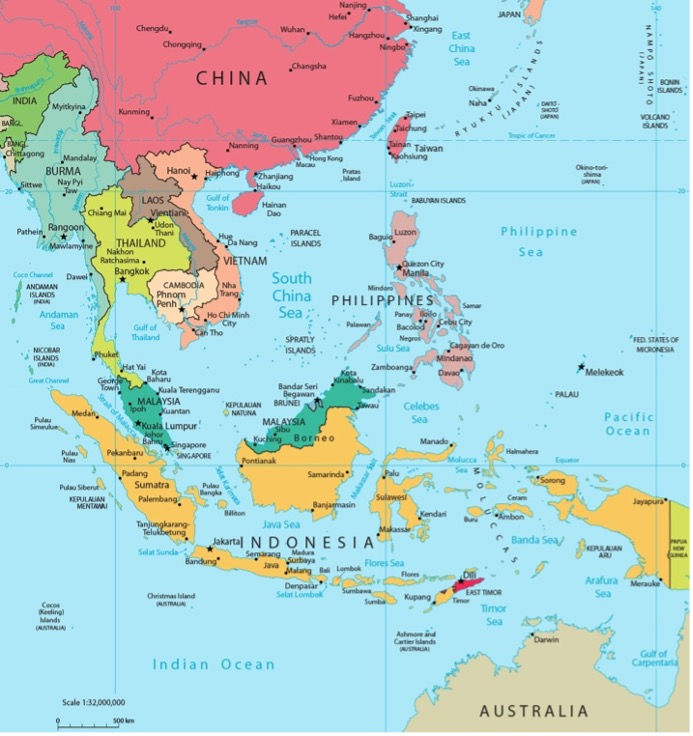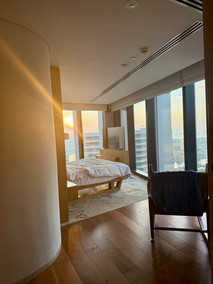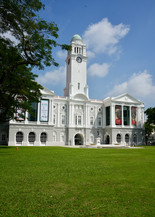SINGAPORE: The 4-day tour
- chuckmeltzer
- Jun 12
- 10 min read
Updated: Jul 23
We arrived in Singapore around 8 AM after a 17-hour flight from LAX. Singapore Airlines Business Class was impressive. The food and service were excellent, and the lay-flat beds have a unique design where you fold down the seat back to create the bed. It was comfortable for me, but my 6'4" husband found it a bit short, though he slept well despite the person snoring behind him. The flight left LA at 11 PM, and I was worried about staying up late for supper service, but the excitement of our new adventure kept me going. Eating late and then sleeping around 2 AM worked out, as we got about 7 hours of decent sleep before the next meal. I watched three movies, including "A Complete Unknown," which I really enjoyed. Although I'm no longer a big Dylan fan, he was a major figure in my rebellious youth, and I attended a concert with him and The Band at the Nassau Coliseum in 1974, during my senior year of high school. I also recall being pulled over by a cop on our drive back from the Scarsdale train station at 1 AM, despite being a bit stoned, but we managed to smooth things over with the officer.
Getting through customs, collecting baggage, and hailing a taxi took less than 15 minutes. Although you need a Singapore Visitors Card that costs $105, no one asked for it. Despite the warnings about bringing in medication without prior authorization, there was no bag search, so the concern was unnecessary. The takeaway is to bring whatever you need, like Ambien, Trazadone, or Xanax, to combat jetlag, though I find traveling west easier to adjust to than flying east to Europe.
We checked into Andaz Singapore and were fortunate to get an early check-in. I like to treat us to nice hotels, especially after a long flight, to ensure a comfortable first stay, so I booked a 1-bedroom suite. Our room on the 33rd floor has a bathtub with a view of the bay. Although I'm not typically a bath person, I tried it, and it worked wonders on my sore lower back. We previously stayed at the Andaz in Prague and enjoyed it; Hyatt has perfected this boutique hotel brand with its modern, hip spaces.
Why did we choose to explore Singapore? Why do we travel? For us, traveling means experiencing how others live, understanding their culture, appreciating their art and architecture, and tasting their cuisine. Over the years, we have explored a fair amount of Western Europe. We branched out in 2023 when we visited Egypt and Greece in 2023, Eastern Europe Spring 2024 and I traveled to Kenya September 2024. It was time to explore a part of Asia, and Scotty hasn't fully recovered from the despair and poverty experienced in third-world Egypt, so we wanted a distinctly first-world experience, leading us to choose Singapore and Japan. Several friends shared their positive experiences in both locations, making our decision easier.
All I knew about Singapore was not to spit out gum on the street, as it could lead to arrest; luckily, I don't chew gum, so that's not a concern. I had heard it is very clean and safe, with excellent food.
For those unfamiliar with the region, I have included this map:

Here's a concise overview of Singapore. The Republic of Singapore is an island nation and city-state located at the southern tip of the Malay Peninsula. Its modern history began in 1819 when Stamford Raffles founded it as a trading post for the British Empire. Singapore was occupied by Japan in 1942 and returned to British rule in 1945. It achieved self-governance in 1959 and joined the federation of Malaysia in 1963, but ideological differences led to its expulsion in 1965. Despite lacking natural resources, Singapore has become a significant hub for aviation, finance, and maritime shipping. Singapore excels in key social indicators such as education, healthcare, quality of life, personal safety, infrastructure, and housing, boasting a home-ownership rate of 88%.
Our guide explained how the government has successfully achieved these high home ownership rates through a public housing system where the government constructs apartments and sells 99-year leases. In this system, the government monitors potential buyers to maintain a balanced representation among various demographic groups: Chinese (74%), Malay (14%), and Indian (9%). Although the homes are not inexpensive, they are more affordable than private condos, costing about $1.2M for a 1200 square foot unit. After five years, residents can sell their lease to a new owner. We visited one of these buildings, which differ from the subsidized rental public housing commonly seen in the U.S. Instead, they are well-maintained and decent structures. We were impressed by their ability to provide housing for everyone, as we did not encounter any homeless people in Singapore. One building we visited, known as Block 88, is not named like The Park at Bankers Hill and is more austere and utilitarian, yet it is commendable that they have achieved this for most of the population. This tower was 50 stories high with views of some of the estates of those affluent Asians aka "crazy rich Asians"!!!!
Under the leadership of Governor Raffles, Singapore grew and prospered. While initially it was inhabited by mostly people from Malay, by 1860 half of the population of 80,000 were Chinese immigrants.
Singapore was not impacted much during WW I, and afterwards, the British built a large Singapore Naval Base to protect the port and its interests. As WW II loomed, it became more apparent that the Japanese were working their way down from Manchuria towards Malay and Singapore. As Great Britain came under attack at the start of WW II, it left Singapore not as well defended by this naval base as had been intended. The Japanese invasion of Malay culminated in the Battle of Singapore and a British force of 60,000 troops surrendered on 15 February 1942, with about 5000 killed or wounded. Most of the troops were from Australia. The Japanese experienced similar numbers of total killed or wounded. Overall, it was a significant loss for the British and one that delayed plans by them to liberate Singapore in 1945/1946.
The post-war period was chaotic and a critical time in its history to understand how Singapore evolved as to become a self-governing nation. I will spare you all the details, and fast forward to say it became independent on 9 August 1965 with Lee Kuan Yew as the first prime minister. Lee Kuan Yew encouraged rapid economic growth while putting limitations on internal democracy. His party, the PAP, People’s Action Party, remains in power. The second prime minister did not take office until 1990, and in 2004, Lee’s son, became the third prime minister. The minority Workers’ Party holds 10 of the 93 seats in their parliament and on 15 May 2024, the fourth prime minister took off and he was the first one born after the independence.
Let's touch on politics a bit more before returning to our travel experiences. What we truly value in our travels and explorations is gaining a deeper understanding of the people, their culture, and politics, which we don't always study before visiting these places. Last year's journey to Germany and then to Hungary was very enlightening regarding the political evolution of post-war Germany compared to Hungary under Viktor Orban. Learning about Singapore and its politics reveals a society that has thrived under a more rigid autocracy than what we have experienced in the US. The Singaporean government comprises three branches: Executive, Legislature, and Judiciary. The President is elected, and although the role has limited responsibilities, one of them is appointing the prime minister, who leads the executive branch. Singapore has consistently been ranked as one of the least corrupt countries globally, despite being illiberal. One of our guides mentioned that while he values the safety and quality of life, he wishes the government wouldn't dictate personal choices, like prohibiting chewing gum, as he sees it as an individual right.
Alright, enough with the historical background, let's get back to our exploration. After unpacking and showering, we went down for breakfast. The options were ideal—Scotty opted for a western buffet, while I chose an Asian breakfast with dumplings and noodle soup. Later, we decided to visit the Singapore Botanical Gardens, a UNESCO World Heritage Site. With an average temperature of about 88 degrees and high humidity, the climate was quite oppressive, similar to those three-shower summer days in NYC. Strolling through the gardens was a way to acclimate to the environment.
The gardens were breathtaking, featuring a diverse array of tropical plants, enormous fig trees, Ficus, a small rainforest, and a magnificent orchid garden. Given how precious land is in Singapore, having a 200-acre park in the city center is particularly special. Stamford Raffles, the governor in the early 1800s, had an interest in horticulture and began cultivating crops in an experimental garden in 1822. The current botanical gardens were established in 1859.
The National Orchid Garden features 1000 species and 2000 hybrids of orchids. These orchids vary in color, size, shape, and fragrance. One of the sections includes a coolhouse that displays orchids from the highlands, offering a refreshing escape from the heat and making it difficult to depart! Observing the orchids reminds me of Georgia O'Keeffe and their sensual forms.
There was a collection of Bromeliad plants, waterfalls, and a ginger garden that was not blooming. But who needs a blooming ginger when I have my Scotty to look at?
Multiple lakes including one called Swan Lake which has large sculpture installed in the middle of it called Flight of the Swans, which considering there were no live swans, explained the name of that lake.
Afterwards, we returned to the hotel and chose to walk the couple of miles, as we still wanted to stretch our legs following our 17+ hour flight. Although we believe that walking is the best way to explore a city, it might not be ideal when it's 88 degrees and humid. Nevertheless, we persevered. The city boasts incredible modern architecture, with skyscrapers lined up one after another. Green spaces are not typically found on the ground as you might expect in a park, but rather in the middle of buildings, appearing as loggias with mini-pocket gardens in the sky.
During our evening tour, we visited several key attractions, such as the light show at the Gardens by the Bay, had dinner at a hawker center (a local gathering of street food vendors), and even drove through the red-light district.
The city lights up beautifully.
The origins of hawker centers trace back to initial attempts to regulate the safety of street food and generate revenue for the city through rent. City leaders concluded that it would be more hygienic to replace roaming food carts with these centers. These centers can house a few hundred vendors offering a wide variety of food options for everyone. The beef and pork satay were simple and delicious.

There were two light shows on opposite sides of the Gardens by the Bay. One intriguing feature of one show was the use of water to project images, enhancing the visual experience with an additional dimension. The show within the garden used large artificial palms to alter the lights, producing an effect akin to fireworks without actually employing them.
Visiting the red-light district was somewhat unexpected, but Singapore's history is closely linked to its role as a longstanding port for sailors. Where sailors gather, prostitution often follows. Similar to their approach with street food, city officials realized they could better regulate the health of sex workers and generate revenue from the establishments. We decided to stay in our vehicle and take a quick look from our minivan. The area offered something for everyone, including a gay house and some transvestites for those seeking more adventurous experiences. Unlike Amsterdam’s red-light district, there were no sex workers displayed in storefront windows.
The following day, we explored some historic sites along the Singapore River, such as The Fullerton Hotel, the Old Parliament House, Chinatown, and Little India. We also visited the top of Marina Bay Sands SkyPark for a panoramic view of Singapore. I hadn't noticed any grocery stores on the streets and was curious to see one, as I believe you can learn a lot about a place by visiting its supermarkets. We discovered a network of underground malls that included supermarkets. We visited a Marks & Spencer market and left wishing we had one in San Diego due to its variety, quality, and size, as I still miss Oliver’s Market in Windsor when grocery shopping in San Diego.
We also walked through one of the outdoor markets that sell both produce and have a wet market. We didn’t encounter any bats flying around and potentially spreading diseases.
But what we did see was a black chicken, which did not look particularly appetizing. The prickly thorn-covered fruit below is known as a durian; it's known for its strong pungent odor, which has been compared to everything from rotting flesh to dirty gym socks. Trust me when I say one whiff is all you need to gag at the idea of eating one.
After visiting the historic Fullerton Hotel, we crossed the Singapore River on a bridge which was forged in Scotland and brought by ship to be built in Singapore.
We strolled through some of the bazaars.
There was one street in which there was a church, a Hindu temple and a mosque.
We even stumbled upon a Jewish Synagogue. Apparently, there was a migration of Jews from Baghdad shortly after Sir Stamford Raffles established Singapore as a trading post in 1819. Today, it remains home to approximately 2500 Jews.
Scattered throughout the city are murals done by one artist depicting life in Singapore in earlier times. They evoke some of the same images you might imagine from the Bowery on the lower east side with the tenements and tight living quarters. Scott decided to have a “seat” on one of them.
Singapore has maintained several streets featuring historic heritage houses. The contrast between the very old and the very new is striking.
The following day, we added a tour focusing on the fall of Singapore during World War II. As I mentioned in my earlier summary, the British surrendered after just a week of fighting in February 1942. The Japanese had strategically outmaneuvered them, despite having only a third of the troops. They also launched their attack on Singapore from Thailand, which was unforeseen. The formal surrender took place at what used to be a Ford factory.
We visited the Kranji War Memorial and Cemetery. Gravestone after gravestone listing all the young men and women (nurses) who died.
The British soldiers were primarily held at Changi, which is now where the airport is located. The conditions were appalling, as were all prison camps during WW2, regardless of location.
While touring with our guide, an unrelated observation was about transportation. Owning a car in Singapore is quite costly. A car buyer must first obtain a 10-year certificate of entitlement, the price of which fluctuates in bi-monthly auctions and can reach up to $84,000, depending on the car. Car prices are also about double what we currently pay (this blog is being written as new tariffs are being introduced, so it's uncertain). Singapore implemented this program in the early 1990s to reduce air pollution and street congestion. Considering the island is smaller than NYC, mass transit is generally the better choice for most Singaporeans, yet there were still numerous luxury cars driven around by the affluent.
I realized I haven't shared details about the food we enjoyed, aside from the morning breakfast buffets. We ate well, mostly simple dishes like satay, noodles, curries, and dumplings, all of which were delicious.
The final sightseeing highlight was seeing the Merlion of Singapore, a mythical creature featuring a lion's head and a fish's body. "Singapura" translates to "lion city," while the fish body symbolizes the city's beginnings as a fishing village.












































































































































Comments